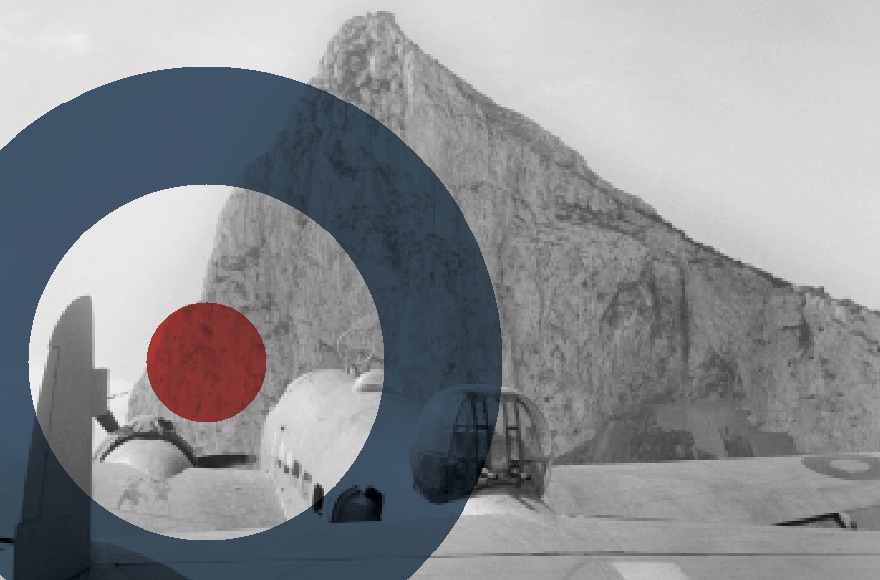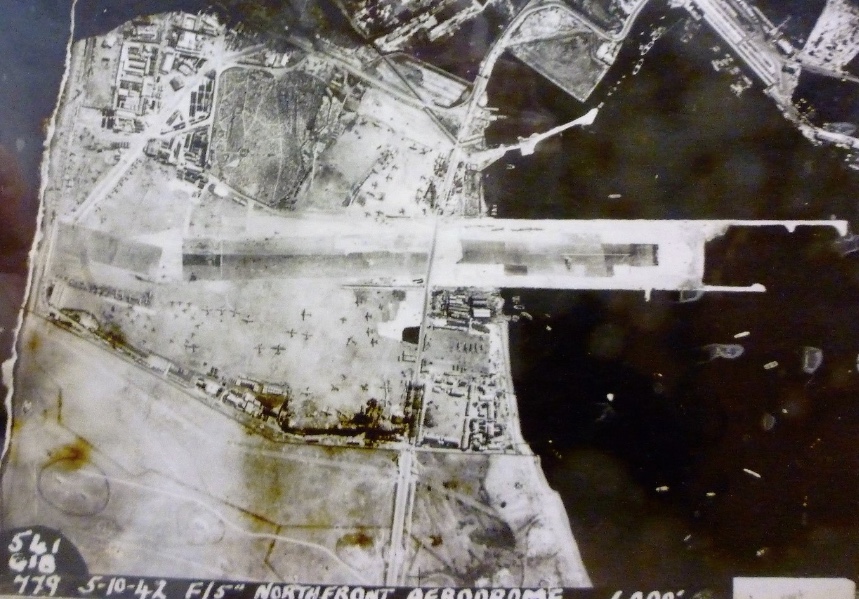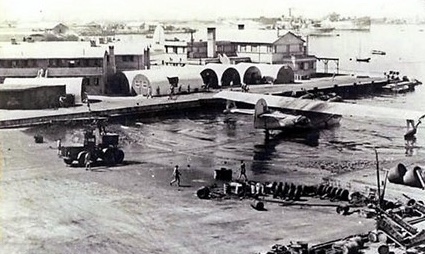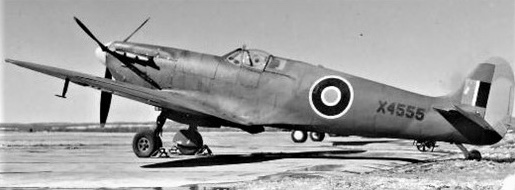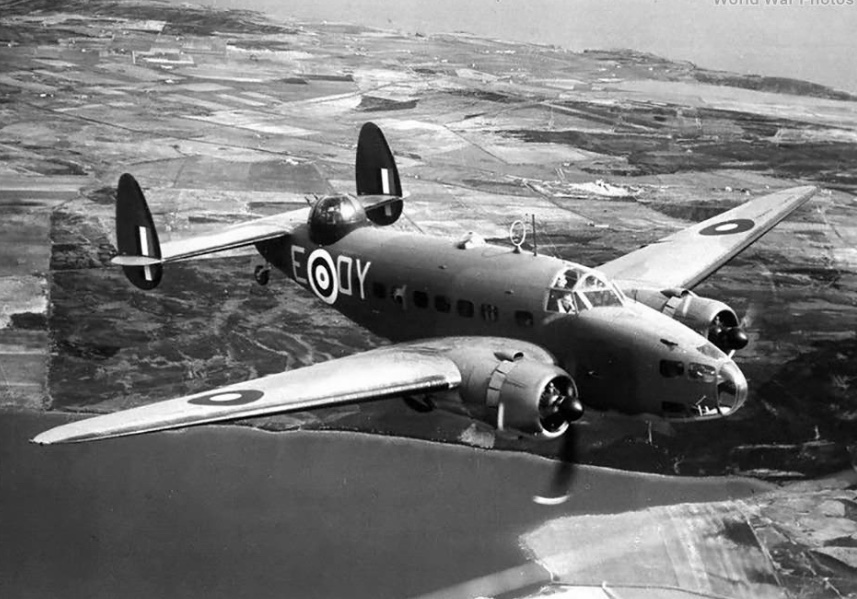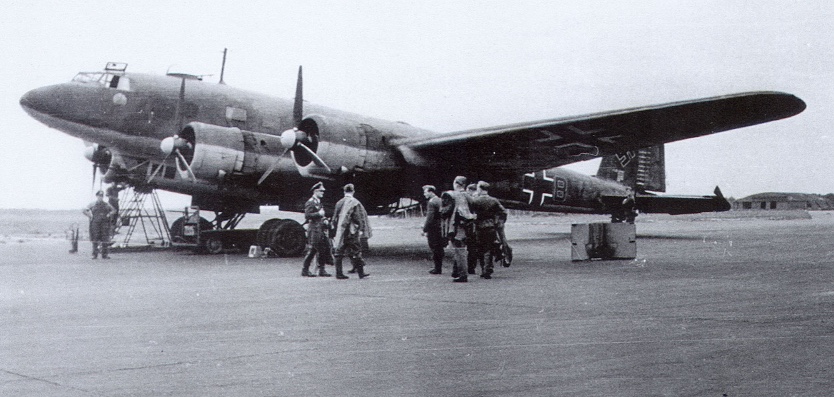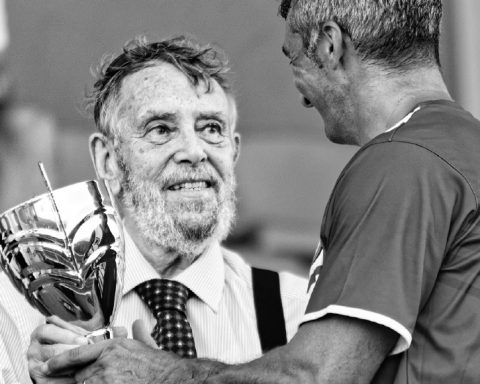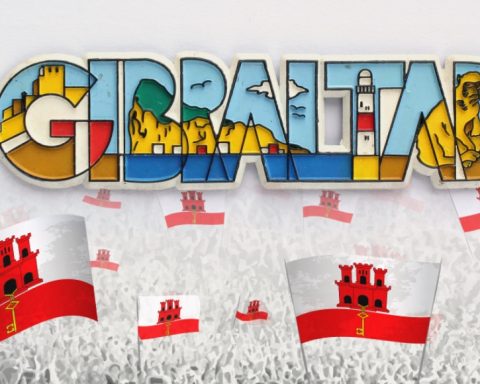PART 2
On July 7th 1940 a Sunderland attached to 202 Squadron while carrying out reconnaissance off the North African Coast, was a attacked by three French fighters, she shot down two and returned to Gibraltar riddled with bullet holes and a wounded gunner, this was the first encounter with the enemy aircraft and the first casualty. On September 14th a London flying boat were shot down by a French fighter over Casablanca, and in October while on an anti U Boat patrol an aircraft of 202 Squadron co-operated with surface craft destroying two Italian submarines, the Durbo and Gondar.
In May 1941 the ageing London and Swordfish float-planes were being replaced by Catalinas. Squadron Leader Harger took over the Squadron. On one of the early missions, four German Condors attacked a Catalina while out on a long range convoy escort, a battle ensued, and the Condors were fought off, two of the Condors failed to return to base.
By September 1941, New Camp was virtually complete, and the RAF found the Operations Room in the Tower to be too small and moved to New Camp.
On December 21 1941, Air Commodore Simpson was appointed to Gibraltar and soon after, No.200 Group was disbanded and all flying in Gibraltar came under the control of RAF Gibraltar, responsible to Headquarters Coastal Command.
In late 1941, No.233 Squadron arrived with the Hudson aircraft, at this time there were number 807, 812, 813 and 824 squadrons of the Feet Air Arm operating Fulmers and Swordfish.
Earlier in 1942 saw an increase in U boat activities in the Western Approaches and Western Mediterranean. Gibraltar was now showing its important strategic location. With the capitulation of France, Germany now had bases along the entire Atlantic Coast, and it was suspected, were also using Spanish ports surreptitiously. This generated a need for a better photo reconnaissance of the immediate area, especially since Spain was fortifying the area around the Bay
In January 1942, photo reconnaissance Spitfires were sent to Gibraltar along with the appropriate staff who could interpret the results. The flights of these aircraft were kept most secret, and the flights were designated RTF flights, only those directly involved were aware of what these flights were about. These operations continued over Spain and North Africa, recorded by the Germans across the border, but unaware of their purpose.
On the 1st of April 1942, the first Italian air attack on Gibraltar took place with little damage to the rock, but to the surprise of the Italians, the Spanish antiaircraft guns joined in the defence of the Rock. The Italians lost three aircraft in the raid.
Up to this time, the airport had been a Fleet Air Arm establishment, but on the 1st of May, 1942, it became RAF North Front, under Wing Commander Young, and New Camp was officially designated RAF New Camp under the command of Group Captain Bolland, with the Fleet Air Arm of attached to it.
As part of the plans for Operation Torch, the invasion of North Africa, work was started on the Area Combined Headquarters in the dockyard tunnel.
On May 6th 1942, Lord Gort was transferred to Malta and was replaced by a Lt. General Mason McFarlane.
No.202 Squadron, was now flying Catalinas and Sunderlands with attachments from number 10 RAAF Sunderland Squadron and Nos. 240, 209 and 413 Squadrons all with Catalinas.
On June 9th a Catalina of 240 Squadron, attacked and sank the Italian submarine Zaffiro.
On June 13th 1942, convoy MW4, consisting of six merchant ships, escorted by a battleship, two carriers, three cruisers, and minelayer and nine destroyers, left Gibraltar for Malta. Thus commenced Operation Harpoon. Aircraft from Gibraltar provided air escort and anti U Boat patrols west of Gibraltar and up to 4° E, the limits of their range. During the seven days that RAF Gibraltar were involved, the aircraft flew 105 sorties with a total of 848 hours.
Very few people in Gibraltar were aware of the pending invasion of North Africa, codenamed Operation Torch, activities accelerated in many quarters. Aircraft began to arrive in Gibraltar in crates to be assembled on the airport. A Special Erection Party arrived for this purpose. On the 15th of September, 70 Spitfires, 22 Hurricanes, and five Hurricane bombers, 15 special tractors and six crates of spares arrived in Gibraltar for assembly. In 11 days all the aircraft had been assembled and flight tested.
On June 29th 1942, an Italian raid destroyed one Hudson and a BOAC Whitley, also damaging several crates on the dispersal area. As Gibraltar had no fighter cover, 18 of the assembled Spitfires were formed into a fighter squadron.
Aircraft continued to arrive in crates, causing havoc on the runway, as these aircraft were parked on either side and on every available space around North Front.
On August 20th, a Senior Flying Control Officer arrived to take over the duty which up to now had been carried out by a duty pilots.
There were several inherent problems with the North Front Airport, the flare path lights would often go out as the cables ran across the road to Spain and were often damaged by the traffic, telephone communication was elementary, dust in the dry and mud in the wet, was a problem, the control tower, which was situated in the original Judge’s Box of the Racecourse, gave an excellent view of the starting point of the race but a poor view of the runway. Another very important problem was the lack of an alternate landing area in the event of an emergency.
In October 1942, there was a race against time to complete all the requirements for Operation Torch. ACHQ which was to be in the dockyard tunnel was not completed, so it was moved to Ragged Staff Tunnel temporarily. Fortunately by the time the operation was ready, so was ACHQ and it was moved into the dockyard tunnel.
On October 20th during an Italian raid on Gibraltar, an incendiary bomb was dropped on the Spitfire dispersal area but failed to do any damage, a stick of anti-personnel bombs fell in La Linea causing some damage and casualties.
Throughout this period, a shuttle service had been operating, using mainly Liberators, carrying UK evacuees from Malta to the UK via Gibraltar. On the 31st of October 1942, a Liberator of No.511 Squadron overshot the runway and crashed into the sea with 32 evacuees on board, the crew escaped minor injuries but 14 passengers were killed either from the impact or drowned.
Aircraft continued to arrive in crates to be assembled in vast numbers, creating increasing problems in parking, the crew were working 24 hours using searchlights in order to have everything ready by four AM., on the 8th of November. The runway extension was now 1350 yards.
It was obvious to the Germans watching Gibraltar from La Linea, that something was afoot, but security was so tight, that they did not know exactly what was on.
On October 31st 1942, North Front was declared a protected area, army sentries patrolled the area and everyone entering or leaving here would checked, the entire area was lit by searchlights with armed guards keeping watch behind the lights.
On the airport there were Hudsons, of 233, 500 and 608 Squadrons, Mosquitoes of 540 PRU Squadron, Spitfires of No. 4 PRU Squadron and a special meteorological flight of two Hudsons. There were 650 aircraft standing by.
At 0618 hours on the 8th of November 1942, a telephone call from ACHQ, where General Eisenhower and his staff, operating out of the dockyard tunnel, ordered the barriers on the road to Spain to be closed until further notice, no one was allowed to cross into Gibraltar over the runway.
Operation Torch was about to begin.
By the 12th of November, pressure eased up as the airport in Oran came into use, the statistics for this period in Gibraltar are impressive and even by today’s standards, would be hard to beat. Rainfall during this month was very high and caused some headaches, but operations continued relentlessly, not a single day during this month was flying interrupted..
Article supplied by History Society Gibraltar.
Email: historysocietygibraltar@hotmail.com
Dedicated On the 100th anniversary in 2018, to RAF Gibraltar, by the History Society Gibraltar.

